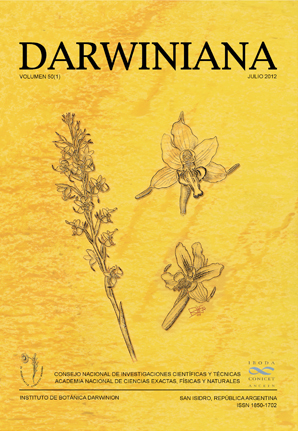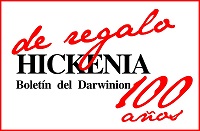PLANTAS AROMÁTICAS CON ÓRGANOS SUBTERRÁNEOS DE IMPORTANCIA CULTURAL EN LA PATAGONIA ARGENTINA: UNA APROXIMACIÓN A SUS USOS DESDE LA ETNOBOTÁNICA, LA PERCEPCIÓN SENSORIAL Y LA ANATOMÍA
DOI:
https://doi.org/10.14522/darwiniana.2014.501.390Palabras clave:
Aroma, estructuras secretoras, Mapuche, percepciones organolépticas, saborResumen
Se analiza la etnobotánica y anatomía de cinco especies aromáticas de uso medicinal y/o comesti-ble altamente valoradas en la Patagonia argentina: Valeriana clarionifolia, V. carnosa (Valerianaceae), Azorella monantha, Osmorhiza chilensis y Eryngium paniculatum (Apiaceae). El principal énfasis ha sido la caracterización de las estructuras secretoras de sus órganos subterráneos y su posible vinculación con las percepciones sensoriales y usos dados por los pobladores. El trabajo etnobotánico se realizó en dos comunidades indígenas Mapuches de la Provincia de Neuquén y en otras dos de la Provincia de Chubut, totalizando 53 entrevistas. El trabajo anatómico consistió en la observación estructural y ultraestructural de las estructuras secretoras. Los informantes indicaron que E. paniculatum es principalmente usada para tratar trastornos digestivos y hepáticos, O. chilensis para problemas de la visión y A. monantha como urinaria y antitusiva; además los órganos subterráneos de estas tres especies seconsumen crudos y/o cocidos. Las especies de Valeriana son usadas principalmente como analgésicas,digestivas, antitusivas y en síndromes culturales. El sabor y el aroma son las principales propiedades sensoriales usadas para reconocer y usar las especies de Valeriana y O. chilensis. A. monantha y E. paniculatum son reconocidas por sus características morfológicas, aunque también se valoran por su sabor y aroma. Las observaciones microscópicas revelan la presencia de cavidades secretoras esquizógenas en O. chilensis, E. paniculatum y A. monantha y abundante presencia de almidón. En Valeriana spp. se observa la peridermis con elevado contenido de aceites esenciales como gotas. Se concluye que estas cinco especies poseen atributos organolépticos originados en estructuras anatómicas especializadas, los que en parte explicarían sus empleos alimenticios y/o medicinales.
Descargas
Publicado
Cómo citar
Número
Sección
Licencia

A partir de 2012, esta obra está licenciada bajo una Licencia Creative Commons Atribución-NoComercial 2.5 Argentina .
Cualquier obra derivada deberá estar previamente autorizada con nota escrita de los editores.







